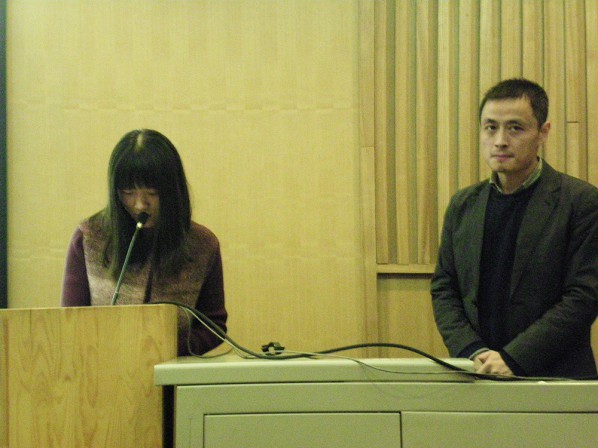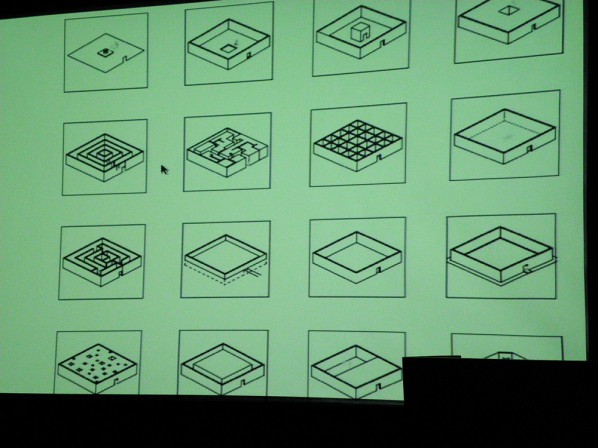
At 18:30 on December 23, 2013, the Design Workshop lecture series invited Tang Keyang, Doctor of Architecture and Design of the School of Design, Harvard University, an independent curator, and Director Architect of Tang Keyang Studio, to give a lecture at the red chair lecture hall in CAFA. The theme of his speech was thinking on the combination of knowledge and practice.
This lecture was divided into two parts: firstly, he explained drawing methods of the design process; secondly, he shared his design ideas with the combination of some specific finished projects.
Diagram
Tang Keyang thought the use of a diagram was a very crucial part in the design process. Different from the painting which was the pursuit of a pretty decorative effect, it aimed at revealing the relationship between design process and elements, to establish a materialized relationship. A Diagram is either a material carrier, or gives a scene meaning. The so-called scene referred to the relationship between the elements of the design, and the nature of the design which is not a clear result of “what it is”, but a changing relationship. A Diagram could explain the development of things and changing paths, a variety of paths constituted structures. When in discussion with clients, one should achieve three basic effects on image, path and structure. Before the design, a designer should have a clear performance in mind, meaning that the reproduction of design, ensures the realisation of the design.

Ten exhibitions and architectural practices
Tang Keyang has established a complete set of curatorial methodology, which is closely established around the situation, path, and homogeneous structure. His first exhibition was “Historic Building and Living Garden”, which was presented in a building in Dresden Germany, built by Westerners in the 18th century according to the pattern of a Chinese garden, and it was an exhibition of a Chinese garden in the venue of a Chinese garden. This situational construction could inspire the audience to think, it didn’t only exhibit the works related to a Chinese garden, but also revealed the contemporary view of a Chinese garden, thus creating a multi-layered overlapping of the new and old, Chinese and foreign. The exhibition hall consisted of lots of separated small rooms, and Tang Keyang exhibited the works by means of juxtaposition, because he believed that the focus was not an individual work, but the relationship between the works. It was also held in Belgium after the completion of the German exhibition. The hall in Belgium was a huge single room, thus he built many false walls which were made up of plain white cloths in order to reconstruct the atmosphere of a garden and produce a dialog between works. Not only saving on budget, but also using lighting systems to create an ambiguous effect, constructing a changing situation.

In addition, Tang Keyang planned a literature exhibition “Painting Hills Project” for Prof. LaoZhu. The object of the exhibition was not a material artwork, but the transmission of LaoZhu’s concept. The form of the exhibition was on the basis of literature, and aided by installation, video, sculpture, systematically showcasing the 24-year “Painting Hills Project” and the discussion triggered by related issues. He planned the “Traces and Things” exhibition in the Palace Museum, where his intention was to weaken the image pattern, strengthening the concept of the writing of Chinese characters, in order to highlight the theme of the writing. So he used a glass barrier to blur the appearance of the works, so that only the reflections of the works were seen. The audience remembered the writing instead of the specific Chinese characters during the visiting process. He once planned an exhibition called “In the Village”, he precisely controlled sunlight in the paths of the interior space, made the works pretty and highlighted by the sunlight, instead of using specialized lighting equipment.
Tang Keyang is very good at using translucent materials, such as glass, steel mesh walls. He thought the translucent property was very ambiguous, they were the lens rather than the objects. To better reflect the changing nature of things, as well as being easier to adapt to the surrounding environment. It was vividly reflected in “Reversal Miracle”, an exhibition of photography by Shi Minfeng, using reversal film, a common photographic technique. When the artist reversed the pictures of incomplete caves, it was unexpected that it “reproduced” Buddha’s images instead of the “elimination”. It was because of some interesting technical reasons: firstly, when the three-dimensional projections of the caves were black and white films, a strong depth disappeared, leaving the relationship of protruded and recessed surfaces, in reversing the brightness and darkness, large blocks of darkness replaced the bright blocks, if a man still followed the visiting path of the original space, the relationship of the image would reverse – now it seemed that Buddha was behind the walls. In order to strengthen the creative concept of the artist, Tang Keyang designed movable walls with transparent fronts but opaque backs, and in this installation it was feasible to reverse the images, which just fit the meaning of the work.
In the curatorial process, Tang Keyang was not only a curator, but also played the role of artist. He hoped that artists would exhibit their works in accordance with space, rather than simply display the works in an exhibition hall. His exploration offers a lot of inspiration, triggering a more in-depth thinking about exhibition design.
Text and photo: Zhang Gaoshan, translated by Chen Peihua and edited by Sue/ CAFA ART INFO




























